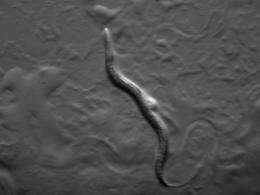'Selfish' DNA in animal mitochondria offers possible tool to study aging

(ĚÇĐÄĘÓƵ) -- Researchers at Oregon State University have discovered, for the first time in any animal species, a type of “selfish” mitochondrial DNA that is actually hurting the organism and lessening its chance to survive – and bears a strong similarity to some damage done to human cells as they age.
The findings, just published in the journal PLoS One, are a biological oddity previously unknown in animals. But they may also provide an important new tool to study human aging, scientists said.
Such selfish mitochondrial DNA has been found before in plants, but not animals. In this case, the discovery was made almost by accident during some genetic research being done on a nematode, Caenorhabditis briggsae – a type of small roundworm.
“We weren’t even looking for this when we found it, at first we thought it must be a laboratory error,” said Dee Denver, an OSU associate professor of zoology. “Selfish DNA is not supposed to be found in animals. But it could turn out to be fairly important as a new genetic model to study the type of mitochondrial decay that is associated with human aging.”
DNA is the material that holds the basic genetic code for living organisms, and through complex biological processes guides beneficial cellular functions. Some of it is also found in the mitochondria, or energy-producing “powerhouse” of cells, which at one point in evolution was separate from the other DNA.
The mitochondria generally act for the benefit of the cell, even though it is somewhat separate. But the “selfish” DNA found in some plant mitochondria – and now in animals – has major differences. It tends to copy itself faster than other DNA, has no function useful to the cell, and in some cases actually harms the cell. In plants, for instance, it can affect flowering and sometimes cause sterility.
“We had seen this DNA before in this nematode and knew it was harmful, but didn’t realize it was selfish,” said Katie Clark, an OSU postdoctoral fellow. “Worms with it had less offspring than those without, they had less muscle activity. It might suggest that natural selection doesn’t work very well in this species.”
That’s part of the general quandary of selfish DNA in general, the scientists said. If it doesn’t help the organism survive and reproduce, why hasn’t it disappeared as a result of evolutionary pressure? Its persistence, they say, is an example of how natural selection doesn’t always work, either at the organism or cellular level. Biological progress is not perfect.
In this case, the population sizes of the nematode may be too small to eliminate the selfish DNA, researchers said.
What’s also interesting, they say, is that the defects this selfish DNA cause in this roundworm are surprisingly similar to the decayed mitochondrial DNA that accumulates as one aspect of human aging. More of the selfish DNA is also found in the worms as they age.
Further study of these biological differences may help shed light on what can cause the mitochondrial dysfunction, Denver said, and give researchers a new tool with which to study the aging process.
More information: %2F10.1371%2Fjournal.pone.0041433
Journal information: PLoS ONE
Provided by Oregon State University
















